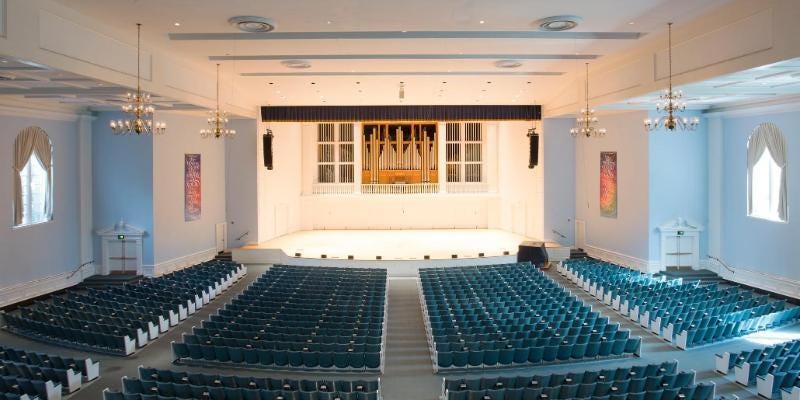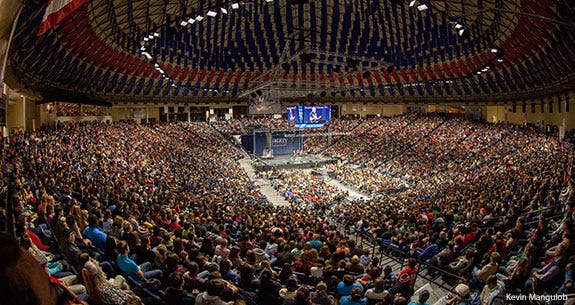I recently finished a book called Eight O'Clock Chapel by Cornelius Howard Patton. If you’re thinking to yourself “Wow, Cornelius? That sounds like a very 19th century name,” you’re right. He was a very 19th century person.
The book, though written in the 1920’s, is about the experience of undergraduate education in New England during the 1880’s. The title comes from the fact that most private colleges of the time included a compulsory religious service as part of their daily life on campus.
Even by the 1920’s, this practice seemed strange and ancient. While mandatory chapel was not terribly popular among students in the 1880’s, the author contends that it had persisted up to that point because the student bodies of the period were “small and homogenous.” He contends that the changes in the scale and student population during the intervening decades made practices like this impossible.
But what exactly did he mean by “small and homogenous” in his own time?

The way it used to be
Let’s start with what our man Cornelius means by “small.”
In 1880, Harvard had the largest student body of any American college or university. It had 886 students.
Yale was the next largest with 687 students. Perhaps more typical examples of the era would be places like Boston University with 107 students or Tufts with 63.
It would, thus, be typical for incoming classes at a college to be somewhere around one hundred students or fewer. Even by 1920, this was unusually small. All the colleges surveyed in 1880 had at least doubled their population forty years on. Dartmouth had a nine-fold increase in that period.
As for “homogenous,” we need to be clear about what is in play for our author.
Most of the colleges in his study exclusively enrolled white students. They were also mostly single-sex mens’ colleges at the time. That demographic homogeneity was consistent between 1880 and 1920. So what changed?
Cornelius seems mostly concerned about religious background, national origin, and “culture” (broadly defined). So while the student bodies, enlarged though they were, in the 1920’s were still made up of white men, their backgrounds now held less in common.
The biggest factor was that cultural Protestantism was no longer ubiquitous. The author asserts that mandatory chapel was sustainable because every 1880’s student grew up with exposure to Protestant faith and practice. He is very clear in noting that many of these students were not interested in religion, per se, but they were capable of “passing” as practicing Protestants for the purposes of public ceremony.
This changed around the turn of the 20th century as Catholic and Jewish students made up a bigger share of the population. Many of these students were also immigrants or the children of immigrants who had recently come to the industrializing United States.
Their arrival also overlapped with many new students who were part of the nouveau riche, the children of America’s class of industrial barons. While they may have been wealthier than previous generations of students, they did not share college-going norms. Their fathers had gotten wealthy without going to college, but they now expected their sons to earn the college diploma, that mark of social standing that had once been the exclusive domain of the “gentleman.” This population of students was less willing to accept the college and its chapel services for the sake of tradition; those traditions were as foreign to them as they were to students who had immigrated to the country.
From our perspective today, a college with 1000 students would still qualify as “small.” We would also likely say that a school made up entirely of white men was “homogenous.” But that degree of homogeneity and smallness alone was insufficient to sustain the cultural practices of a bygone era.

Practice and Belief
Cornelius would have his readers believe that mandatory religious services on college campuses was a thing wholly of the past.
It’s true that it became a much less common practice, but if he stepped on the campus of my alma mater, Wheaton, he’d find a familiar sight. Three times per week at mid-morning, up to 2000 students enter the college chapel and do something. Maybe there’s music. Maybe there’s a faculty speaker. The event is not church, but it is clearly religious in tone and intention.
Wheaton is not alone in this. At religious colleges around the country, this is a community norm. It was in place when Cornelius was writing in 1920, and it never went away.
Wheaton is larger and less homogenous in many respects than the colleges of 1920. It is co-educational. Its students come from around the country and throughout the world. While most students are Protestant, there are also Orthodox, Catholic, and Anabaptist students. Its racial composition would be inconceivably diverse one hundred years ago.
So what holds mandatory chapel in place at Wheaton and other religious colleges?
Small enough
Wheaton has about 2000 students. Biola has 3,500. Liberty University has 15,000. All of them mandate chapel attendance. Do colleges that big really qualify as “small”?
My contention is that they’re simply “small enough for everyone to fit in one room.” That’s the only necessary criterion. If you can fit everyone together and call something “chapel,” then you can have chapel. After all, many of these students come from a megachurch background where being surrounded by thousands of co-religionists is a weekly routine.
So long as you can get together, the colleges just need to ensure a sufficient homogeneity of religiosity. How do they do that?
Homogenous where it matters
Students at these religious colleges are not strictly homogenous in any of the demographic terms we usually use. But they are homogenous in the degree of their religious identification.
As part of an application to Wheaton, potential students must get a letter of recommendation from a teacher to testify to their academic potential and from a spiritual leader to testify to their religious commitment. Additionally, application essay prompts specifically ask for descriptions of students’ religious beliefs and values. Once these students get to campus, they’ll be expected to affirm a community covenant that demands their abstention from otherwise legal practices like smoking or drinking at the legal age.
This matters because it’s a level of explicit religious confirmation that was left implicit in the 1880’s. In Cornelius’ day, the college was Protestant by default, no longer by design. They went to chapel because it was seen as part of any gentleman’s education. Students were not expected to confirm their orthodoxy because they were unified by cultural Protestantism, not a Protestantism of universal practice.
College chapel is possible because of a homogeneity of belief, not of demographics. The students at these campuses have allowed themselves to be explicitly identified and affirmed as Christian and have chosen to submit to norms and obligations that go above and beyond the law. They do this because they believe that being explicitly Christian on an explicitly Christian campus offers them something important.
What exactly that “something” is will be different for different students. One piece of it, though, is the feeling of being surrounded by thousands of other students who have also made a commitment to seeking that something and seeking it together.
These campuses are small enough to fit into one room.
They are homogenous in their interest in being explicitly Christian in a place designated for the explicit Christian.
Seeking homogeneity
I’ve focused on one phenomenon here, but I think it can be extended.
What is a fraternity or sorority? It’s a group small enough to fit in one house. They police their own homogeneity by assessing and inviting only those candidates who “fit” with the established culture of their community. This creates a small, homogenous body within the wider large, heterogenous campus. Although Greek houses are often demographically homogenous, they also tend toward a cultural homogeneity which serves as an important unifier.
What is a thematic community? It’s a group small enough to live in one dorm, often one floor of one dorm. It’s homogenous in sharing at least one interest. Let’s say you live in an “Outdoor Activities” thematic community. You’ll know that lots of people on your floor will be open to the idea of going for a hike on the weekend. This may not be the defining feature of your college experience, but having a floor-wide hiking culture is only possible because of an explicit homogeneity of belief (the belief in this case being “hiking is fun”).
I’d be interested in extending this to how it applies to uncommon colleges, to student groups, to single-sex colleges, and to many more places. It makes me wonder whether college students tend to seek out a place that feels small and homogenous, whether that’s an entire college or a sub-unit within a university.
Is “small and homogenous” what we’re always looking for when we look for a place to belong?
Can you find belonging when you feel yourself to be a in a “large and heterogenous” place?
-Matt





Any group gets together over a common interest. Homogeneity gets a bad rap but it's always a common interest that pulls any group of individuals together. Small is a good discussion point. For many people, "small" is a group where I know everyone's name. When I don't, it's no long small.
Good discussion.
And I really like the "old" photo that looks "old" therefore is "old" :-)